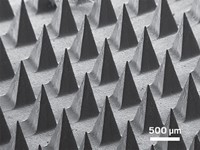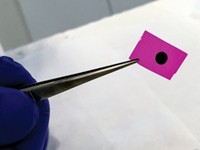Advertisement
Grab your lab coat. Let's get started
Welcome!
Welcome!
Create an account below to get 6 C&EN articles per month, receive newsletters and more - all free.
It seems this is your first time logging in online. Please enter the following information to continue.
As an ACS member you automatically get access to this site. All we need is few more details to create your reading experience.
Not you? Sign in with a different account.
Not you? Sign in with a different account.
ERROR 1
ERROR 1
ERROR 2
ERROR 2
ERROR 2
ERROR 2
ERROR 2
Password and Confirm password must match.
If you have an ACS member number, please enter it here so we can link this account to your membership. (optional)
ERROR 2
ACS values your privacy. By submitting your information, you are gaining access to C&EN and subscribing to our weekly newsletter. We use the information you provide to make your reading experience better, and we will never sell your data to third party members.
Analytical Chemistry
Solid Contrast Agent Enables Long-Term MRI
Injectable material forms a solid oxygen sensor that works for at least a month without the need for an invasive procedure
by Celia Henry Arnaud
April 28, 2014
| A version of this story appeared in
Volume 92, Issue 17
An injectable contrast agent for magnetic resonance imaging that coalesces into a solid now enables long-term monitoring of oxygen levels in tissues without the need for an invasive procedure, which is required to implant standard oxygen electrodes or a solid MRI contrast agent (Proc. Natl. Acad. Sci. USA 2014, DOI: 10.1073/pnas.1400015111). The new material maintains the concentration of the contrast agent in the tissue of interest for extended periods of time, permitting repeated quantitative measurements. Michael J. Cima and coworkers at Massachusetts Institute of Technology make the sensors from a saline suspension of oxygen-responsive dodecamethylpentasiloxane embedded in a support matrix of polydimethylsiloxane (PDMS). In rats, the injected PDMS particles coalesced into a solid sensor “depot” in muscle tissue, and there were no signs of an adverse tissue reaction. By using the right combination of MRI pulse sequences, the signal from PDMS is eliminated and the oxygen-responsive signal is preserved. The researchers used the sensors to measure partial pressure of oxygen in the tissue of the rats as they breathed gas streams containing different amounts of oxygen or as they experienced restricted blood flow to a limb. The sensors remained functional for at least a month after injection. By using different contrast agents and support materials, the same strategy could be used to make sensors optimized for other analytes, the researchers suggest.





Join the conversation
Contact the reporter
Submit a Letter to the Editor for publication
Engage with us on Twitter